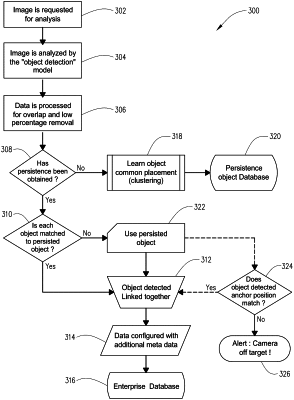| CPC G06V 20/52 (2022.01) [G06F 18/217 (2023.01); G06F 18/23 (2023.01); G06V 10/60 (2022.01)] | 12 Claims |

|
1. An image analysis method comprising:
a. capturing a plurality of images with an image capturing device over a period of time;
b. detecting an object of interest in each of the images with an object detection model;
c. determining the approximate location of the object of interest in each of the plurality of images with the object detection model;
d. clustering the approximate locations of the object of interest in the plurality of images to learn the approximate location of the object of interest;
e. storing the learned location of the object of interest as a persisted object of interest in a persistence object database;
f. repeating steps a-e for a plurality of objects of interest;
g. capturing an image in real time in which a specific object of interest is expected to be visualized; and
h. determining whether the specific object of interest can be visualized in the real time image, wherein
i. if the specific object of interest is visualized, matching the specific object of interest with a persisted object of interest in the persistence object database; and linking the visualized specific object of interest with an additional feature in the real time image; and wherein if the specific object of interest cannot be visualized in the real time image;
(1) identifying a persisted object of interest from the persistence object database that is at the expected location of the specific object of interest;
(2) linking the identified persisted object of interest with an additional feature in the real time image; and
(3) determining whether the additional feature is properly located relative to the location of the identified persisted object of interest.
|